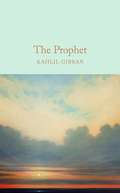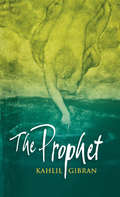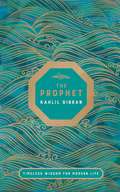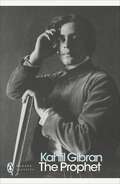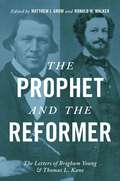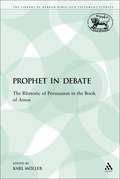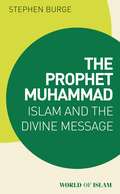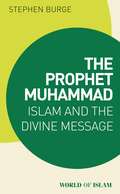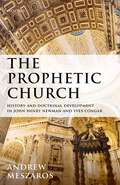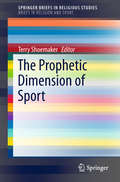- Table View
- List View
Prophecy, Piety, and Profits: A Conceptual and Comparative History of Islamic Economic Thought (Palgrave Studies in Islamic Banking, Finance, and Economics)
by Ayman RedaThis book examines, in greater depth than the existing literature, the history of Islamic economic thought. It seeks to introduce Islamic views to debates surrounding critical economic concepts, such as scarcity, wealth, poverty, charity, usury, self-interest, rationality, and markets. It does so through a comparative analysis with the views of Judaic, Christian, and secular economic thought. “Prophecy” is meant to signify the theoretical dimension of religion, while “piety” represents its practical element; neither part is feasible without the other. Together, prophecy and piety inform the Islamic view of economic concepts and phenomena. This view seeks to adjust our approach to profits, both in this world and the next, and seeks to reexamine what is truly profitable and worthy of sacrifice.
Prophecy, Poetry and Hosea (The Library of Hebrew Bible/Old Testament Studies)
by Gerald MorrisThe books of the Latter Prophets have traditionally been treated as persuasive speeches, and interpreted according to their rhetoric. At the same time, interpreters recognize the poetic form of much prophecy. This study takes up the notion of the 'prophet' as 'poet', focusing on word-play in Hosea and on the lyrical plot of that book; the case is made for treating Hosea as a stark, full-length poem of inexhaustible power.
Prophecy without Contempt: Religious Discourse In The Public Square
by Cathleen KavenyThe culture wars have as much to do with rhetorical style as moral substance. Cathleen Kaveny focuses on a powerful stream of religious discourse in American political speech: the Biblical rhetoric of prophetic indictment. It can be strong medicine against threats to the body politic, she shows, but used injudiciously it does more harm than good.
Prophesying the Past: The Use of Israel's History in the Book of Hosea (The Library of Hebrew Bible/Old Testament Studies)
by Else K. HoltHosea and the Hosean tradition play an important role in the internal Israelite dispute about the nature of God and his relation to the world and Israel. Hosea refers to traditions of the past in which the interdependence between Yahweh and Israel, and in particular Yahweh's care for his people, are recurrent themes. The prophet can presuppose that certain portions of these traditions, both "historical" and "theological", are known to his audience, but it is his claim that what is not known to Israel is the demand that is inherent in Yahweh's past dealings with his people, the demand for exclusive worship of Yahweh. In his "historical" retrospections, Hosea enphasizes time after time that Israel has been chosen, not for a life of passive retreat, but to serve Israel's God alone. This he proclaims as the true knowledge of God.
The Prophet (Macmillan Collector's Library #9)
by Kahlil GibranUtterly unique and beloved around the world, The Prophet is a collection of twenty-six poetic essays by the Lebanese artist, philosopher and writer Khalil Gibran. Telling the story of the prophet Al-Mustafa and his conversations with various acquaintances as he returns home after a long absence, the book touches on subjects of universal concern, including love, friendship, passion, pain, religion and freedom.Thought-provoking, comforting and wise, the simple truths of The Prophet remain compelling and rewarding to this day.Designed to appeal to the booklover, the Macmillan Collector's Library is a series of beautiful gift editions of much loved classic titles. Macmillan Collector's Library are books to love and treasure.
The Prophet
by Kahlil GibranOne of the most beloved classics of our time, Kahlil Gibran's The Prophet has been translated into many languages and sold millions of copies since its original publication in 1923. Its 28 chapters consist of poetic reflections on the human condition, presented as discussions between the prophet, Almustafa, and the people of the city of Orphalese. Gibran was a Lebanese poet, philosopher and artist, and his fame and influence have spread far beyond the land of his birth. In America, where he lived for the last twenty years of his life, he began to write in English, and his books of poetry, illustrated with mystical drawings that have been compared to those of William Blake, are now known all over the world. The Prophet is timeless in its insight into the human condition, and in its calm philosophy and spontaneous joy can be found the expression of the deepest impulses of the human heart and mind.
The Prophet: With Original 1923 Illustrations By The Author
by Kahlil GibranA 20th century classic, The Prophet is thought-provoking, comforting and wise, and its simple truths remain compelling and rewarding to this day.Utterly unique and beloved around the world, The Prophet is a collection of twenty-six poetic essays by the Lebanese artist, philosopher and writer Kahlil Gibran. Telling the story of the prophet Al-Mustafa and his conversations with various acquaintances as he returns home after a long absence, the book touches on subjects of universal concern, including love, friendship, passion, pain, religion and freedom.
The Prophet: The Spiritual Classic (Capstone Classics)
by Kahlil Gibran Tom Butler-BowdonPart of the bestselling Capstone Classics Series edited by Tom Butler-Bowdon, this collectible, hard-back edition of The Prophet provides an accessible and insightful introduction to this timeless spiritual work The Prophet is an inspirational book of 26 poetry fables written in English by Lebanese-American poet and writer Kahlil Gibran. One of the most translated books in history, Gibran’s famous work has been translated into over 100 different languages since its first publication in 1923. The book provides timeless spiritual wisdom on universally-shared aspects of life, such as giving, buying and selling, beauty and friendship, eating and drinking, crime and punishment and spirituality and religion. The book follows Almustafa, a man who has waited for twelve years for a ship to take him from the island of Orphalese back to his home. He has come to know the people on the island, who consider him a wise and insightful man. On the day Almustafa’s ship finally arrives, he feels a deep sadness. The local elders ask him not to leave. Almustafa speaks of his philosophy of life and the truths he has discovered to the gathered crowd. His words have an almost magical quality to them. As he prepares to board his ship, it becomes clear that Almustafa’s words do not refer to his journey home, but rather to the world he came from before he was born. The Prophet is a metaphor for the mystery of life and an exploration of the human condition. Inspirational and extremely readable for modern audiences, this classic text teaches us: We should be glad of the experience of coming into the world The separation you feel from other people is not real True marriage gives both people space to develop their individuality Enjoying your work is expressing your love for whoever benefits from it Sorrow makes space for more joy in another season of life Featuring an insightful introduction from the editor, The Prophet: The Spirituality Classic is a must-read book for anyone interested in exploring the undeniable truths of life we all share.
The Prophet: The Spiritual Classic (Capstone Classics)
by Kahlil Gibran Tom Butler-BowdonPart of the bestselling Capstone Classics Series edited by Tom Butler-Bowdon, this collectible, hard-back edition of The Prophet provides an accessible and insightful introduction to this timeless spiritual work The Prophet is an inspirational book of 26 poetry fables written in English by Lebanese-American poet and writer Kahlil Gibran. One of the most translated books in history, Gibran’s famous work has been translated into over 100 different languages since its first publication in 1923. The book provides timeless spiritual wisdom on universally-shared aspects of life, such as giving, buying and selling, beauty and friendship, eating and drinking, crime and punishment and spirituality and religion. The book follows Almustafa, a man who has waited for twelve years for a ship to take him from the island of Orphalese back to his home. He has come to know the people on the island, who consider him a wise and insightful man. On the day Almustafa’s ship finally arrives, he feels a deep sadness. The local elders ask him not to leave. Almustafa speaks of his philosophy of life and the truths he has discovered to the gathered crowd. His words have an almost magical quality to them. As he prepares to board his ship, it becomes clear that Almustafa’s words do not refer to his journey home, but rather to the world he came from before he was born. The Prophet is a metaphor for the mystery of life and an exploration of the human condition. Inspirational and extremely readable for modern audiences, this classic text teaches us: We should be glad of the experience of coming into the world The separation you feel from other people is not real True marriage gives both people space to develop their individuality Enjoying your work is expressing your love for whoever benefits from it Sorrow makes space for more joy in another season of life Featuring an insightful introduction from the editor, The Prophet: The Spirituality Classic is a must-read book for anyone interested in exploring the undeniable truths of life we all share.
The Prophet: Penguin Classics (Penguin Modern Classics)
by Robin Waterfield Khalil GibranFirst published in the 1920's, THE PROPHET an inspirational, allegorical guide to living, the book is perhaps the most famous work of religious fiction of the Twentieth Century and has sold millions of copies in more than twenty languages. Gibran'sprotagonist, called simply 'the Prophet', delivers spiritual, yet practical, homilies on a wide variety of topics central to daily life: love, marriage and children; work and play; possessions, beauty, truth, joy and sorrow, death and many many more.
The Prophet and the Reformer: The Letters of Brigham Young and Thomas L. Kane
by Matthew J. Grow and Ronald W. WalkerUntil his death in 1877, Brigham Young guided the religious, economic, and political life of the Mormon community, whose settlements spread throughout the West and provoked a profound political, legal, and even military confrontation with the American nation. Young first met Thomas L. Kane on the plains of western Iowa in 1846. Young came to rely on Kane, 21 years his junior, as his most trusted outside adviser, making Kane the most important non-Mormon in the history of the Church. In return, no one influenced the direction of Kane's life more than Young. The letters exchanged by the two offer crucial insights into Young's personal life and views as well as his actions as a political and religious leader. The Prophet and the Reformer offers a complete reproduction of the surviving letters between the Mormon prophet and the Philadelphia reformer. The correspondence reveals the strategies of the Latter-day Saints in relating to American culture and government during these crucial years when the "Mormon Question" was a major political, cultural, and legal issue. The letters also shed important light on the largely forgotten "Utah War" of 1857-58, triggered when President James Buchanan dispatched a military expedition to ensure federal supremacy in Utah and replace Young with a non-Mormon governor. This annotated collection of their correspondence reveals a great deal about these two remarkable men, while also providing crucial insight into nineteenth-century Mormonism and the historical moment in which the movement developed.
The Prophet and the Reformer: The Letters of Brigham Young and Thomas L. Kane
Until his death in 1877, Brigham Young guided the religious, economic, and political life of the Mormon community, whose settlements spread throughout the West and provoked a profound political, legal, and even military confrontation with the American nation. Young first met Thomas L. Kane on the plains of western Iowa in 1846. Young came to rely on Kane, 21 years his junior, as his most trusted outside adviser, making Kane the most important non-Mormon in the history of the Church. In return, no one influenced the direction of Kane's life more than Young. The letters exchanged by the two offer crucial insights into Young's personal life and views as well as his actions as a political and religious leader. The Prophet and the Reformer offers a complete reproduction of the surviving letters between the Mormon prophet and the Philadelphia reformer. The correspondence reveals the strategies of the Latter-day Saints in relating to American culture and government during these crucial years when the "Mormon Question" was a major political, cultural, and legal issue. The letters also shed important light on the largely forgotten "Utah War" of 1857-58, triggered when President James Buchanan dispatched a military expedition to ensure federal supremacy in Utah and replace Young with a non-Mormon governor. This annotated collection of their correspondence reveals a great deal about these two remarkable men, while also providing crucial insight into nineteenth-century Mormonism and the historical moment in which the movement developed.
A Prophet in Debate: The Rhetoric of Persuasion in the Book of Amos (The Library of Hebrew Bible/Old Testament Studies)
by Karl MöllerAn investigation of the literary structure and rhetorical challenge that prompted the book's production. Moller argues that the book of Amos captures and presents the debate between Amos and his eighth-century audience. When read in the light of Israel's fall, the presentation of Amos struggling (and failing) to convince his contemporaries of the imminent divine punishment functions as a powerful warning to subsequent Judaean readers.
A Prophet Like Moses: Prophecy, Law, and Israelite Religion
by Jeffrey StackertJeffrey Stackert addresses two of the oldest and most persistent problems in biblical studies: the relationship between prophecy and law in the Hebrew Bible and the utility of the Documentary Hypothesis for understanding Israelite religion. These topics have in many ways dominated pentateuchal studies and the investigation of Israelite religion since the nineteenth century, culminating in Julius Wellhausen's influential Prolegomena to the History of Ancient Israel. Setting his inquiry against this backdrop while drawing on and extending recent developments in pentateuchal theory, Stackert tackles the subject through an investigation of the different presentations of Mosaic prophecy in the four Torah sources. His book shows that these texts contain a rich and longstanding debate over prophecy, its relation to law, and its place in Israelite religion. With this argument, A Prophet Like Moses demonstrates a new role for the Documentary Hypothesis in discussions of Israelite religion. It also provides an opportunity for critical reflection on the history of the field of biblical studies. Stackert concludes with an argument for the importance of situating biblical studies and the study of ancient Israelite religion within the larger field of religious studies rather than treating them solely or even primarily as theological disciplines.
The Prophet Muhammad: Islam and the Divine Message (World of Islam)
by Stephen BurgeProphets serve as intermediaries between the human and divine worlds, granting them a special status in history across diverse religions and cultures. For Muslims, the Prophet Muhammad (570–632 CE) represents the culmination of the line of monotheistic prophets, including Abraham, Moses and Jesus. In his own lifetime, Muhammad overcame opposition and brought reforms, firmly establishing a thriving community of believers which would become a major world civilisation. Today, the Prophet's life and actions continue to inspire the Muslims worldwide.The Prophet Muhammad presents an illuminating portrait of Muhammad in his capacity as God's messenger and an exemplary figure to Muslims. Revealing the challenges and triumphs of prophecy, Stephen Burge examines how prophets have inspired faith communities' relationship with the Divine, and one another. In doing so, this engaging account elucidates the enduring influence of prophecy and the profound legacy of the Prophet Muhammad.
The Prophet Muhammad: Islam and the Divine Message (World of Islam)
by Stephen BurgeProphets serve as intermediaries between the human and divine worlds, granting them a special status in history across diverse religions and cultures. For Muslims, the Prophet Muhammad (570–632 CE) represents the culmination of the line of monotheistic prophets, including Abraham, Moses and Jesus. In his own lifetime, Muhammad overcame opposition and brought reforms, firmly establishing a thriving community of believers which would become a major world civilisation. Today, the Prophet's life and actions continue to inspire the Muslims worldwide.The Prophet Muhammad presents an illuminating portrait of Muhammad in his capacity as God's messenger and an exemplary figure to Muslims. Revealing the challenges and triumphs of prophecy, Stephen Burge examines how prophets have inspired faith communities' relationship with the Divine, and one another. In doing so, this engaging account elucidates the enduring influence of prophecy and the profound legacy of the Prophet Muhammad.
The Prophet of Cuernavaca: Ivan Illich and the Crisis of the West
by Todd HartchCatholic priest and radical social critic Ivan Illich is best known for books like Deschooling Society and Medical Nemesis that skewered the dominant institutions of the West in the 1970s. Although commissioned in 1961 by American bishops to run a missionary training center in Cuernavaca, Mexico, Illich emerged as one of the major critics of the missionary movement. As he became a more controversial figure, his center evolved into CIDOC (Centro Intercultural de Documentación), an informal university that attracted a diverse group of intellectuals and seekers from around the world. They came to Illich's center to learn Spanish, to attend seminars, and to sit at the feet of Illich, whose relentless criticism of the Catholic Church and modern Western culture resonated with the revolutionary spirit of the times. His 1967 article, "The Seamy Side of Charity," a harsh attack on the American missionary effort in Latin America, and other criticisms of the Church led to a trial at the Vatican in 1968, after which he left the priesthood. Illich's writings struck at the foundations of western society, and envisioned utopian transformations in the realms of education, transportation, medicine, and economics. He was an inspiration to a generation of liberation theologians and other left-wing intellectuals. In The Prophet of Cuernavaca Todd Hartch traces the development of Illich's ideas from his work as a priest through his later secular period, offering one of the first book-length historical treatments of his thought in English.
The Prophet of Cuernavaca: Ivan Illich and the Crisis of the West
by Todd HartchCatholic priest and radical social critic Ivan Illich is best known for books like Deschooling Society and Medical Nemesis that skewered the dominant institutions of the West in the 1970s. Although commissioned in 1961 by American bishops to run a missionary training center in Cuernavaca, Mexico, Illich emerged as one of the major critics of the missionary movement. As he became a more controversial figure, his center evolved into CIDOC (Centro Intercultural de Documentación), an informal university that attracted a diverse group of intellectuals and seekers from around the world. They came to Illich's center to learn Spanish, to attend seminars, and to sit at the feet of Illich, whose relentless criticism of the Catholic Church and modern Western culture resonated with the revolutionary spirit of the times. His 1967 article, "The Seamy Side of Charity," a harsh attack on the American missionary effort in Latin America, and other criticisms of the Church led to a trial at the Vatican in 1968, after which he left the priesthood. Illich's writings struck at the foundations of western society, and envisioned utopian transformations in the realms of education, transportation, medicine, and economics. He was an inspiration to a generation of liberation theologians and other left-wing intellectuals. In The Prophet of Cuernavaca Todd Hartch traces the development of Illich's ideas from his work as a priest through his later secular period, offering one of the first book-length historical treatments of his thought in English.
Prophet, Son, Messiah: Narrative Form and Function in Mark 14-16 (The Library of New Testament Studies #97)
by Edwin K. BroadheadEmploying a formalistic analysis set within a broad tradition-history context, this analysis investigates the relationship between Passion story and Gospel story in Mark. Broadhead looks especially at the narrative morphology and narrative syntax of individual stories, their relation to the Passion account, and their interaction with the larger world of the narrative. He reveals in Mark 14-16 a carefully-crafted text which is intimately linked to the larger Gospel story. This is particularly true of the strategies of characterization and of the christological portrait they support. This book invites reconsideration of basic questions about Mark: its nature and purpose; the role of the community behind it; assumptions about authorial intention; patterns of development for the Gospel tradition; and the form and function of the Gospel genre.
The Prophetic Body: Embodiment and Mediation in Biblical Prophetic Literature
by Anathea E. Portier-YoungBiblical prophecy involves more than words: it is always also embodied. After assessing the prevalence, implications, and origins of a logocentric model of biblical prophecy, Anathea E. Portier-Young proposes an alternative, embodied paradigm of analysis that draws insights from disciplines ranging from cognitive neuroscience to anthropology. Portier-Young provides a new, embodied paradigm of analysis for biblical prophecy, offering tools for academics and students to study a wide range of texts with new emphasis on the body. If offers a broadly-based account of prophetic embodiment. The author first assesses the prevalence, implications, and origins of a logocentric model of biblical prophecy, then proposes an alternative, embodied, and interdisciplinary paradigm. She argues that embodied religious experience and affect are not merely antecedent or coincidental to prophetic mediation but are both means (how mediation occurs) and objects (part of what is mediated). While Portier-Young's primary aim is to intervene in how biblical scholars understand and talk about prophecy, it has broader implications for how we map the relationships between spoken and written word(s) on one hand and body and praxis on the other. The author provides a game-changing reframing of prophecy that not only changes how we read biblical texts but also funds and energizes our understanding of prophetic witness in the contemporary world.
The Prophetic Body: Embodiment and Mediation in Biblical Prophetic Literature
by Anathea E. Portier-YoungBiblical prophecy involves more than words: it is always also embodied. After assessing the prevalence, implications, and origins of a logocentric model of biblical prophecy, Anathea E. Portier-Young proposes an alternative, embodied paradigm of analysis that draws insights from disciplines ranging from cognitive neuroscience to anthropology. Portier-Young provides a new, embodied paradigm of analysis for biblical prophecy, offering tools for academics and students to study a wide range of texts with new emphasis on the body. If offers a broadly-based account of prophetic embodiment. The author first assesses the prevalence, implications, and origins of a logocentric model of biblical prophecy, then proposes an alternative, embodied, and interdisciplinary paradigm. She argues that embodied religious experience and affect are not merely antecedent or coincidental to prophetic mediation but are both means (how mediation occurs) and objects (part of what is mediated). While Portier-Young's primary aim is to intervene in how biblical scholars understand and talk about prophecy, it has broader implications for how we map the relationships between spoken and written word(s) on one hand and body and praxis on the other. The author provides a game-changing reframing of prophecy that not only changes how we read biblical texts but also funds and energizes our understanding of prophetic witness in the contemporary world.
The Prophetic Church: History and Doctrinal Development in John Henry Newman and Yves Congar
by Andrew MeszarosThe Prophetic Church: History and Doctrinal Development in John Henry Newman and Yves Congar is a historical and a systematic account of tradition, doctrinal development, and the theology of history, with a particular focus on the contributions of two modern Catholic figures, John Henry Newman (1801-1890) and Yves Congar (1904-1995). It is structured around two overarching themes: the 'subject' and 'history' in their relationship to doctrinal development. In addition, the thought of both Congar and Newman is interwoven throughout. Andrew Meszaros contextualizes and surveys Congar's reception of Newman. He explains the appeal of Newman and provides concrete evidence that would substantiate the nature and extent of Newman's influence on Congar, and thereby indirectly, on Vatican II. Meszaros also discusses doctrinal development with special attention to the subject and history. These treatments are based on the subjective and historical 'motors' or 'causes', as it were, of doctrinal development. He then develops a theology of doctrine and doctrinal development as inspired by Newman and Congar. In its reflection on the meaning of the Doctrinal Economy, this study contributes to the theological problem of history and doctrine by synthesizing and honing contributions of these two great thinkers of modern Catholic theology. It is precisely some of the key differences between Newman and Congar that make it theologically enriching to study them together.
The Prophetic Church: History and Doctrinal Development in John Henry Newman and Yves Congar
by Andrew MeszarosThe Prophetic Church: History and Doctrinal Development in John Henry Newman and Yves Congar is a historical and a systematic account of tradition, doctrinal development, and the theology of history, with a particular focus on the contributions of two modern Catholic figures, John Henry Newman (1801-1890) and Yves Congar (1904-1995). It is structured around two overarching themes: the 'subject' and 'history' in their relationship to doctrinal development. In addition, the thought of both Congar and Newman is interwoven throughout. Andrew Meszaros contextualizes and surveys Congar's reception of Newman. He explains the appeal of Newman and provides concrete evidence that would substantiate the nature and extent of Newman's influence on Congar, and thereby indirectly, on Vatican II. Meszaros also discusses doctrinal development with special attention to the subject and history. These treatments are based on the subjective and historical 'motors' or 'causes', as it were, of doctrinal development. He then develops a theology of doctrine and doctrinal development as inspired by Newman and Congar. In its reflection on the meaning of the Doctrinal Economy, this study contributes to the theological problem of history and doctrine by synthesizing and honing contributions of these two great thinkers of modern Catholic theology. It is precisely some of the key differences between Newman and Congar that make it theologically enriching to study them together.
The Prophetic Dimension of Sport (SpringerBriefs in Religious Studies)
by Terry ShoemakerBringing together leading scholars in the fields of Religion and Sport, this book examines the prophetic dimension of sport, to arrive at a better understanding of the nature of sports in the United States. By detailing and analyzing particular sports, a portrait of sport as an important space for social and political critique emerges. Sport is indisputably an important cultural phenomenon in the United States. Each year millions attend sporting events, track the statistics and lives of sports stars, collect memorabilia, engage in fantasy sports, and play various sporting games. But increasingly, sport is also a space for public articulations regarding social and political issues within the United States. What are we to make of these particular articulations? What do they tell us about the nature of sport in the United States? How are these social and political critiques formed? Why do sporting voices seem to carry more weight at this moment in history? Ideally suited for use in undergraduate and graduate courses, this book offers a new way of thinking about the connection between sport and religion in a secularizing society. By analyzing various sports and particular historical moments, the chapters supply a unique example of the relevance of sport as it pertains to social and political critique.
The Prophetic Faith
by Martin Buber Jon D. LevensonOriginally published in English in 1949, The Prophetic Faith features Martin Buber's readings of select biblical prophets—especially Isaiah and Deborah, the only female prophet and judge in the Hebrew Bible. In an approach that combines insights from biblical prophecy with a concern for events in the here and now, Buber outlines his interpretation of biblical revelation. Infused with an anti-institutional—some have said anarchic—sensibility, Buber discusses the notion of kingship as portrayed in the Bible and provides an account of human suffering in an extended discussion of the Book of Job. Anticipating those today who describe themselves as "spiritual but not religious," Buber gives pride of place to a personal God outside of formal religious and legal strictures.Featuring a new introduction by Jon D. Levenson, The Prophetic Faith encourages a renewed appreciation for the Hebrew Bible and its relevance to the practical challenges of the present day.




